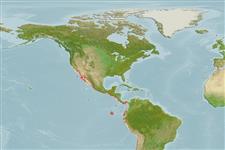>
Syngnathiformes (Pipefishes and seahorses) >
Syngnathidae (Pipefishes and seahorses) > Syngnathinae
Etymology: Hippocampus: Greek, ippos = horse + Greek,kampe = curvature (Ref. 45335).
More on author: Girard.
Environment: milieu / climate zone / depth range / distribution range
Ecologia
marinhas associadas(os) a recifes; não migratória; intervalo de profundidade 0 - 60 m (Ref. 30915), usually 3 - 18 m (Ref. 5227). Subtropical; 37°N - 22°S, 123°W - 70°W
Eastern Pacific: confirmed records from San Diego in California, USA to Peru including the Galapagos Islands.
Reported from the San Francisco Bay by Alexander Agassiz (Ron Fritzsche, pers.comm. 08/09).
Comprimento de primeira maturação / Tamanho / Peso / Idade
Maturity: Lm 5.4 range ? - ? cm
Max length : 30.0 cm TL macho/indeterminado; (Ref. 2850)
Descrição suscinta
Chaves de identificação | Morfologia | Morfometria
Espinhos dorsais (total) : 0; Raios dorsais (total) : 18 - 21.
Nocturnal. Occur in offshore waters, mostly captured by dredging at 10 m or deeper. Occasionally caught at surface. Are often camouflaged within the branches of gorgonians and black coral trees where they are seen to curl their tail around the branches (Ref. 5227). Have been found in the stomachs of Pacific yellowfin tuna and bluefin tuna (Ref. 30915). Ovoviviparous (Ref. 205). The male carries the eggs in a brood pouch which is found under the tail (Ref. 205).
Male carries the eggs in a brood pouch (Ref. 205). Gestation period is 14-15 days depending on temperature (Ref. 30915).
Lourie, S.A., R.A. Pollom and S.J. Foster, 2016. A global revision of the seahorses Hippocampus Rafinesque 1810 (Actinopterygii: Syngnathiformes): taxonomy and biogeography with recommendations for further research. Zootaxa 4146(1):1-66. (Ref. 115213)
Status na Lista Vermelha da UICN (Ref. 130435)
Ameaça para os humanos
Harmless
Uso pelos humanos
Pescarias: espécies comerciais; Aquário: Espécies comerciais
Ferramentas
Relatórios especiais
Baixar XML
Fontes da internet
Estimates based on models
Preferred temperature (Ref.
123201): 19.1 - 28.5, mean 24.3 °C (based on 131 cells).
Índice de diversidade filogenética (Ref.
82804): PD
50 = 0.5000 [Uniqueness, from 0.5 = low to 2.0 = high].
Bayesian length-weight: a=0.00447 (0.00177 - 0.01127), b=3.00 (2.78 - 3.22), in cm total length, based on LWR estimates for this (Sub)family-body shape (Ref.
93245).
Nível Trófico (Ref.
69278): 3.3 ±0.38 se; based on food items.
Resiliência (Ref.
120179): Elevada, tempo mínimo de duplicação da população menor que 15 meses (tm=0.3-0.4).
Fishing Vulnerability (Ref.
59153): Low vulnerability (20 of 100).
Nutrients (Ref.
124155): Calcium = 71.1 [33.9, 167.8] mg/100g; Iron = 1.28 [0.60, 2.43] mg/100g; Protein = 18.7 [17.3, 20.0] %; Omega3 = 0.164 [0.069, 0.364] g/100g; Selenium = 32.1 [12.6, 86.2] μg/100g; VitaminA = 22.8 [5.6, 102.3] μg/100g; Zinc = 1.08 [0.61, 1.78] mg/100g (wet weight);
